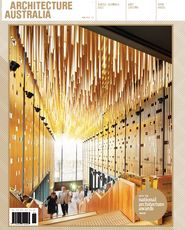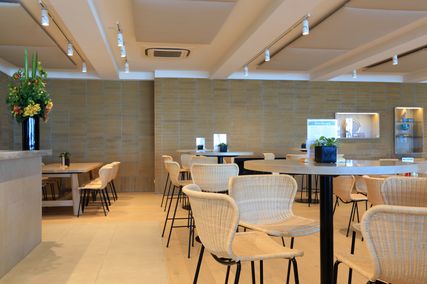Competition and spectacle
Rachel Hurst
When Sarah Murdoch accidentally announced the wrong person as the winner of Australia’s Next Top Model last year it was a life-changing event dramatically captured on national television. Instead of remembering the victor, the audience is much more likely to recall the unfortunate runner-up, Kelsey Martinovich (and the mortified Murdoch). In the happy-ever-after of reality TV, everyone was a winner, with both girls receiving the same prize money, trip to New York and magazine cover shoot. But if such programs have anything to teach us, it’s that we are obsessed with competitions: not just with the winners, but with the nerve-racking ranking of a field of hopefuls, and with endlessly debating whether the judges got it right.
It may be fanciful to liken the Australian Institute of Architects National Awards program and its recognition and promotion of architectural excellence to the salacious quests of popular culture, but the phenomena do share some characteristics – the spectacle (witness the hype of the awards ceremonies as “the architecture profession’s Brownlow”), the suspense and the assumption that awards change careers. As a past national juror in 2009, I can attest to the potential for the meticulous process to do that. This overview of the 2011 awards is from a perspective forever changed by the privilege of that role.
While it is a continuation of that privilege to comment on the latest crop of “contestants,” my first-hand experience of the national jury has left me uneasy at judging through the remote, purely visual medium of online presentations, and a few coincidental visits to projects that have cropped up in the final count. Touring confirmed convincingly something we are all taught in architecture school but occasionally forget in this seductively ocular-centric culture: that there is no substitute for the dynamic, haptic perception of architecture. Even after years of reading drawings and photographs, I can still be surprised by the scale, context and, more importantly, the feel, smell and sound of a place. It seems churlish, then, to query any of the decisions of the jury, who have immersed themselves in the pressure cooker of the tour, with long days and debates in a glamorous Kia van.
During the long drives, one of the more puckish among us would throw out the challenge “What’s your top five?”, testing us to nominate the best five Australian buildings since 1940, urban spaces, engineering structures, or favourite five architects. Like bachelor-lit hero Nick Hornby’s High Fidelity and its motif of list-making, it didn’t really matter what the parameters were, or if we agreed at all in the arguing, but that we did argue, that we were forced to put our opinions on the line. Articulating the values we judge architecture by is a (literally) critical act, and the awards are the most cohesive, comprehensive and public version of that. So, in the spirit of provocation, and at the declared risk of judging books by their covers, here are my top five from this year’s winners, the ones that immediately communicate something beyond competence, beyond respect (after all, that should be the baseline for any state award winner) and rather something risky, something to make you want to visit them, to look beyond the experience of a photograph.
They are Neeson Murcutt’s Castlecrag House, poignant with its consummate interpretation of an architectural continuum, international, local and personal; Donovan Hill’s AM60, an ingenious elevation of commercial typology to something characteristically, almost neurotically, intense and delicate; the Hangar by Peter Stutchbury, for its irresistible synthesis of structural clarity, surgical techné and romantic form; Kerry Hill’s State Theatre Centre of Western Australia, which resolves complex functional issues with schizophrenic sobriety and dazzling funkiness; and Tridente Architects’ Caritas College Junior School External Covered Area, for sheer David and Goliath value-adding to a potentially prosaic project.
These are in no particular order, but chosen with deliberate intention to consider projects across the range of categories, from public to private, large to small. I confess I could have chosen five purely residential works – Durbach Block Jaggers’ sinuous Garden House, the architectural steel toy that is Muir Mendes’s Law Street House, and Domenic Alvaro’s terse Small House, a model for ultra-compact urban dwelling – and wonder if that says more about the finesse with which we continue to handle the sole house in Australian architecture, or about my own predilection for intimate, idiosyncratic works.
Easy to love as the Residential and Small categories remain, this year’s entries are no quaint storybook cottages, but are distinctive for their obdurate materiality and monumentality. From Denton Corker Marshall’s uncompromising Gallery House to the silvering timber monoliths of Tasmanian winners from 1+2 Architecture and Room11, irrespective of budget, the prevailing aesthetic is weighty, potent – built expressions of Bachelard’s “intimate immensity” (The Poetics of Space, ch. 8).
In contrast, this year’s larger works seem to infuse the civic with an almost domestic scale. Perhaps it’s the hysteresis of Glenn Murcutt’s influence, acknowledged this year with the Enduring Architecture Award for the Magney House of 1984. With the exception of AAMI Park’s bubbly global language (forgive the visual pun), the substantial projects across most categories are richly layered and articulated formally, spatially and texturally. It is an idiom best encapsulated in the quality tertiary institutional works of the last five years, or in Fender Katsalidis’s definitive palette of mixed media, asymmetry and graphic identity, and now evident in commercial endeavours like Hassell’s Ecosciences Precinct and one40william. Palatable as the results currently are, particularly in producing active, cross-programming opportunities, one might question whether we are heading towards what Peter Corrigan calls “soft modernism,” a reversal of Le Corbusier’s “monumentalising of the vernacular” (Kenneth Frampton, Modern Architecture, 227). Is the approach in danger of becoming generic and confused – appealing but not memorable? Of course, to design a large building that is singular but not a “one-liner” is extremely difficult (try making a top five of good Australian examples), though Sean Godsell is certainly having a promising go with his emerging RMIT Design Hub.
Across the thirty or so awards, there is a familiar band of firms we have seen commended at national level again and again – practitioners like John Wardle, Angelo Candalepas and BVN who have established such assurance over specific typologies and architectural territories that it must be daunting for younger contenders to attempt to add something new. While it is rewarding to watch the accomplished surety of these usual suspects, the competitive, recurrent nature of the Awards sets up an element of gladiatorial curiosity to see whether there might be an upset (a Martinovich–Murdoch moment). This year, however, sees no such fall from grace; in particular, Johnson Pilton Walker have consolidated their hold on respectfully interpreting the Canberra traditions of politeness, elegant formality and durability, with two awards for the Australian War Memorial Eastern Precinct.
There are other decisions, however, that could be interpreted as upsets: the omission at national level of several state named awards in the Residential category (but then there are so many exceptional house entries); the hint of aesthetic rather than ecological priorities in the Sustainable Awards category, and the modest use of the Heritage category to celebrate the diversity and quality of developments in this somewhat ambiguous area. Like the “wild card” of reality shows, the Small Projects and Colorbond awards allow some manoeuvring room for judges to recognize works that don’t neatly fit the other more typologically consistent categories, and the Heritage category can appropriately promote sensitive readaptation, alongside fastidious restoration. There are also decisions that have special significance – the Commendation for Troppo’s St Mary’s Catholic Primary School and Neeson Murcutt’s Robin Boyd Award – honouring the fine achievements of people who tragically won’t be with us to share their successes at the Awards night at MONA. These truly are upsets in the field of Australian architecture.
Occasionally the Awards have drawn flak for being insular and self-congratulatory. Yet, unlike the all-singing, all-dancing, cooking, renovating, surviving obsessions of popular culture, there is very limited serious exposure of the quest for architectural excellence. Awards themselves are minor events beside the tenacity and complexity of thought required to consistently build good work. It matters not whether we agree with the judges’ decision. We all make our own top five and it’s the willingness to put ourselves, our works and our opinions on the stage of architectural debate that counts.
The Robin Boyd Award for Ambitious Architecture
Rory Hyde
Awards offer a useful chance to stand back and take stock of what we do, to assemble the very best of the thousands of buildings and spaces created in this country every year and reflect on what they say about our discipline. This distillation of excellence should be something we can point to and be proud of; it’s a chance to celebrate the efforts of a few, and to give the rest of us something to aim for.
Awarded projects should exemplify the particular values we believe architecture should embody, and can even act as a means to encourage these values in the future. By recognizing buildings that are very polite to their context, awards can encourage an architecture that doesn’t shout, but which does its duty in the background. By recognizing cheap buildings that manage to scratch out an idea or presence greater than their constituent parts, awards can encourage an architecture that is nimble and smart.
Taken as a whole, this year these awards have encouraged an architecture that is safe. An architecture that doesn’t break too many rules; that’s invariably designed by somebody you’ve heard of; an architecture that won’t leak, let anybody slip, or be blown away. This is a group of buildings that are risk averse. They are clear, consistent, coherent and refined; delivered with utmost professionalism, on time and on budget. They are not by unestablished or untested practices; they are not untested building types that don’t fit neatly into categories; they are not buildings that might have a great front but a less effective rear. These awards celebrate refinement, and punish flaws; they celebrate success, not ambitious attempts.
There are, of course, a number of exceptions to this generalization: AAMI Park by Cox builds on the experimental legacy of Melbourne’s sports precinct established by the Sidney Myer Music Bowl and Olympic Pool to create a formally elegant and ambitious structure that blends engineering smarts with the humorous iconography of inflated soccer balls. NH’s redevelopment of Myer’s Bourke Street store returns the glamour to this fading establishment with a radical restructuring of the interior, capped by a striking gold crown funnelling light deep into the space. Kerry Hill Architects’ State Theatre Centre of Western Australia combines at once an assured civic presence with a delicate materiality and quality of light that deftly packages the spatially and technically complex requirements demanded of a theatre. And it’s heartening to see at least a couple of newcomers to the awards among the long list of established practices – namely Room11 and Muir Mendes, in the housing category.
But even now, I’m reaching. It’s difficult to say how “ambitious” these projects are; again, the word that comes to mind more than any other is “professional.” Professionalism is a virtue to be sure, but one that also suggests an erring on the side of safety, perhaps at the expense of experimentation.
I’m not here to point the finger, and besides, that would be a fruitless task. And to challenge the judgment of our leading professionals and critics would be far too subjective. And as one of the few award systems where the buildings are actually visited, we can’t blame the alluring deception of the photographs. Nor can we take the architects to task, as they face incredibly challenging demands: every building must be green, cheap, saleable, conform to regulations; be on time, on budget, make money, and more often than not, be iconic. It is a culture that creates architecture, not just individuals, and we live in a culture that’s increasingly motivated by money, driven by public relations and regulated by the threat of litigation. In the face of these forces, every one of the projects that makes it into the running for these awards is remarkable.
We could just stop there and say, “oh well, them’s the breaks, better luck next year.” But it’s architecture’s responsibility to carve out new means and models for making sense of this context, and in extreme circumstances – such as the multiple crises that have descended on our country in recent years – to survive it. Solutions to the challenges of today don’t currently exist, and will take much experimentation, ambition and risk to develop. With experimentation, ambition and risk comes failure. And yet the national awards are no place to celebrate failure, so how, then, do we encourage ambition?
Here’s how it could work. Glenn Murcutt’s Enduring Architecture Award this year clearly cements him as our most accomplished architect of residences. Known around the country and the world for his excellence at this scale, he is surely the greatest representative of our fine culture of designing houses. With this in mind, I propose renaming the residential award in his honour, thereby freeing up Robin Boyd to serve as our own patron saint of experimentation and ambition.
I always thought it cruel that Boyd – Australia’s greatest experimenter and innovator – is remembered by the awards program as an architect of houses. He clearly strove for something bigger, but because of his untimely death at the age of just fifty-two he was unable to realize his ambition. And besides, Boyd’s houses leaked! He famously refused to answer the phone when it was raining out of fear that it would be an incensed client. So let’s use this as an opportunity to revise our historical memory.
It is Boyd’s spirit of ambition and innovation that we so sorely need right now if we are to see off the challenges to our discipline and our urban environments. I hereby propose a new award: the Robin Boyd Award for Ambitious Architecture. Start working on your entries for 2012, and don’t worry if it leaks.
Source

Discussion
Published online: 8 Nov 2011
Words:
Rachel Hurst,
Rory Hyde
Images:
Still image from "Australia's Next Top Model"
Issue
Architecture Australia, November 2011
















